2011 Hyundai Sonata air condition
[x] Cancel search: air conditionPage 313 of 380
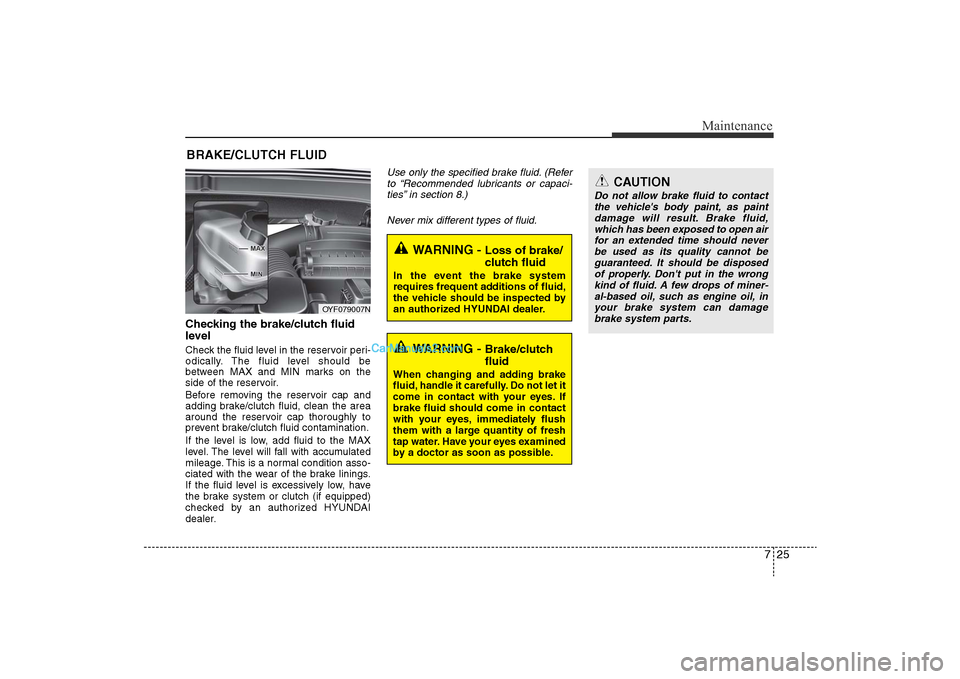
725
Maintenance
BRAKE/CLUTCH FLUIDChecking the brake/clutch fluid
level Check the fluid level in the reservoir peri-
odically. The fluid level should be
between MAX and MIN marks on the
side of the reservoir.
Before removing the reservoir cap and
adding brake/clutch fluid, clean the area
around the reservoir cap thoroughly to
prevent brake/clutch fluid contamination.
If the level is low, add fluid to the MAX
level. The level will fall with accumulated
mileage. This is a normal condition asso-
ciated with the wear of the brake linings.
If the fluid level is excessively low, have
the brake system or clutch (if equipped)
checked by an authorized HYUNDAI
dealer.
Use only the specified brake fluid. (Referto “Recommended lubricants or capaci-ties” in section 8.)
Never mix different types of fluid.
WARNING -
Brake/clutch
fluid
When changing and adding brake
fluid, handle it carefully. Do not let it
come in contact with your eyes. If
brake fluid should come in contact
with your eyes, immediately flush
them with a large quantity of fresh
tap water. Have your eyes examined
by a doctor as soon as possible.
WARNING -
Loss of brake/
clutch fluid
In the event the brake system
requires frequent additions of fluid,
the vehicle should be inspected by
an authorized HYUNDAI dealer.
CAUTION
Do not allow brake fluid to contactthe vehicle's body paint, as paintdamage will result. Brake fluid, which has been exposed to open airfor an extended time should never be used as its quality cannot beguaranteed. It should be disposed of properly. Don't put in the wrongkind of fluid. A few drops of miner- al-based oil, such as engine oil, inyour brake system can damage brake system parts.
OYF079007N
YF HMA 7.QXP 11/25/2009 1:45 PM Page 25
Page 326 of 380
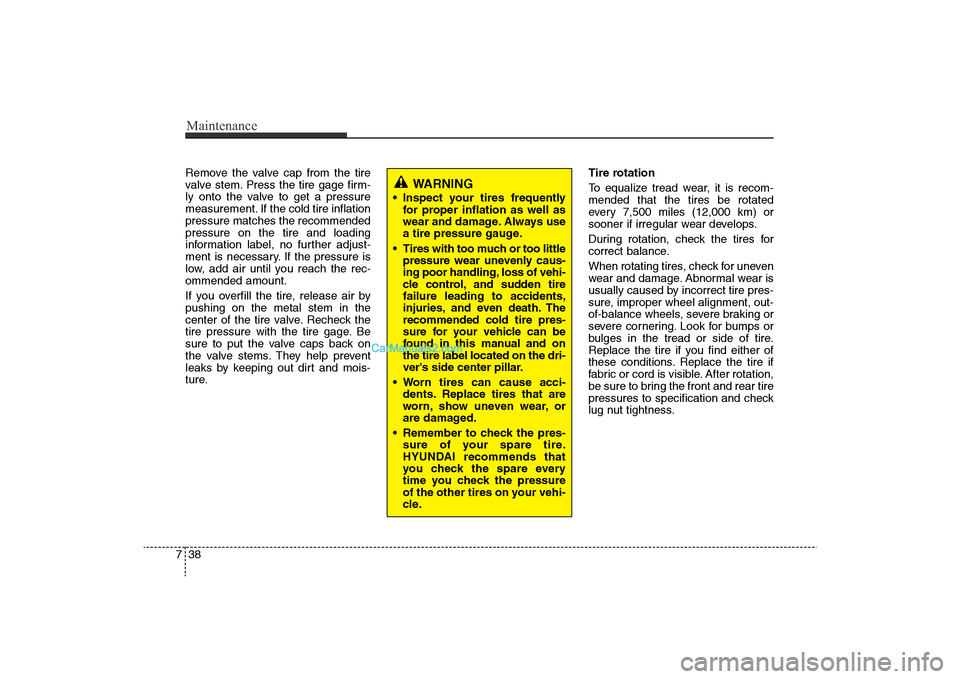
Maintenance38
7Remove the valve cap from the tire
valve stem. Press the tire gage firm-
ly onto the valve to get a pressure
measurement. If the cold tire inflation
pressure matches the recommended
pressure on the tire and loading
information label, no further adjust-
ment is necessary. If the pressure is
low, add air until you reach the rec-
ommended amount.
If you overfill the tire, release air by
pushing on the metal stem in the
center of the tire valve. Recheck the
tire pressure with the tire gage. Be
sure to put the valve caps back on
the valve stems. They help prevent
leaks by keeping out dirt and mois-
ture. Tire rotation
To equalize tread wear, it is recom-
mended that the tires be rotated
every 7,500 miles (12,000 km) or
sooner if irregular wear develops.
During rotation, check the tires for
correct balance.
When rotating tires, check for uneven
wear and damage. Abnormal wear is
usually caused by incorrect tire pres-
sure, improper wheel alignment, out-
of-balance wheels, severe braking or
severe cornering. Look for bumps or
bulges in the tread or side of tire.
Replace the tire if you find either of
these conditions. Replace the tire if
fabric or cord is visible. After rotation,
be sure to bring the front and rear tire
pressures to specification and check
lug nut tightness.
WARNING
• Inspect your tires frequently
for proper inflation as well as
wear and damage. Always use
a tire pressure gauge.
• Tires with too much or too little pressure wear unevenly caus-
ing poor handling, loss of vehi-
cle control, and sudden tire
failure leading to accidents,
injuries, and even death. The
recommended cold tire pres-
sure for your vehicle can be
found in this manual and on
the tire label located on the dri-
ver's side center pillar.
• Worn tires can cause acci- dents. Replace tires that are
worn, show uneven wear, or
are damaged.
• Remember to check the pres- sure of your spare tire.
HYUNDAI recommends that
you check the spare every
time you check the pressure
of the other tires on your vehi-
cle.
YF HMA 7.QXP 11/25/2009 1:48 PM Page 38
Page 332 of 380
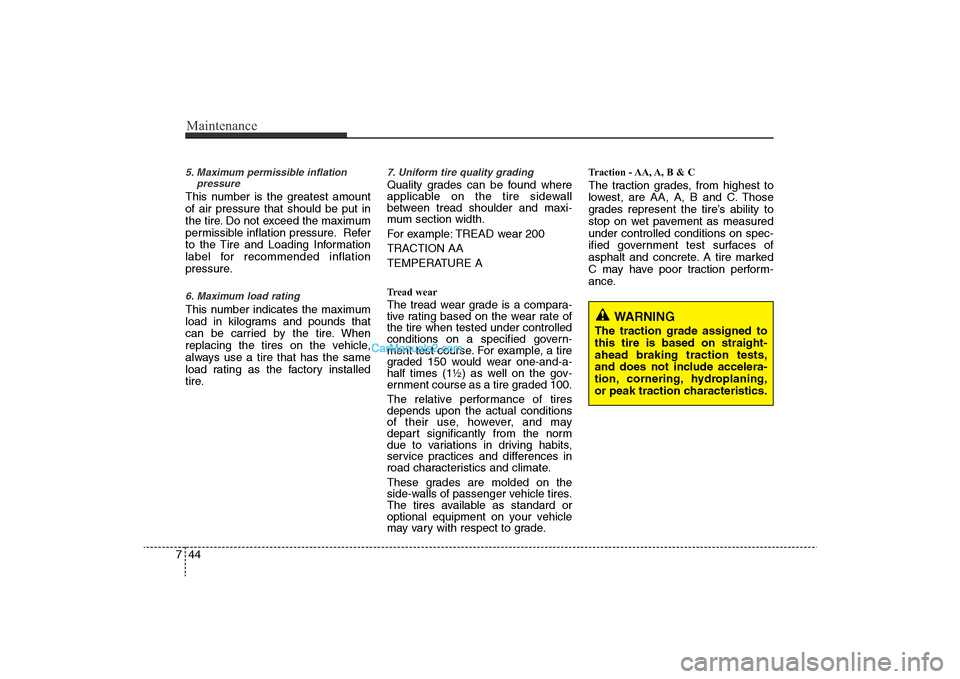
Maintenance44
75. Maximum permissible inflation
pressureThis number is the greatest amount
of air pressure that should be put in
the tire. Do not exceed the maximum
permissible inflation pressure. Refer
to the Tire and Loading Information
label for recommended inflation
pressure.6. Maximum load ratingThis number indicates the maximum
load in kilograms and pounds that
can be carried by the tire. When
replacing the tires on the vehicle,
always use a tire that has the same
load rating as the factory installed
tire.
7. Uniform tire quality grading Quality grades can be found where
applicable on the tire sidewall
between tread shoulder and maxi-
mum section width.
For example: TREAD wear 200
TRACTION AA
TEMPERATURE ATread wearThe tread wear grade is a compara-
tive rating based on the wear rate of
the tire when tested under controlled
conditions on a specified govern-
ment test course. For example, a tire
graded 150 would wear one-and-a-
half times (1½) as well on the gov-
ernment course as a tire graded 100.
The relative performance of tires
depends upon the actual conditions
of their use, however, and may
depart significantly from the norm
due to variations in driving habits,
service practices and differences in
road characteristics and climate.
These grades are molded on the
side-walls of passenger vehicle tires.
The tires available as standard or
optional equipment on your vehicle
may vary with respect to grade.
Traction - AA, A, B & C The traction grades, from highest to
lowest, are AA, A, B and C. Those
grades represent the tire’s ability to
stop on wet pavement as measured
under controlled conditions on spec-
ified government test surfaces of
asphalt and concrete. A tire marked
C may have poor traction perform-
ance.
WARNING
The traction grade assigned to
this tire is based on straight-
ahead braking traction tests,
and does not include accelera-
tion, cornering, hydroplaning,
or peak traction characteristics.
YF HMA 7.QXP 11/25/2009 1:48 PM Page 44
Page 335 of 380
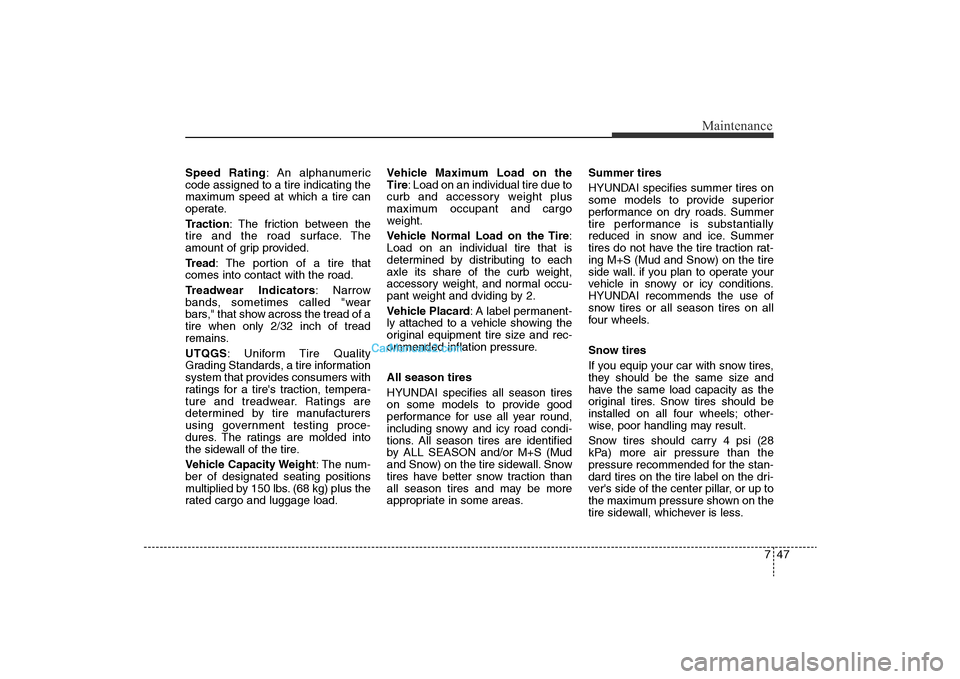
747
Maintenance
Speed Rating: An alphanumeric
code assigned to a tire indicating the
maximum speed at which a tire can
operate.
Traction : The friction between the
tire and the road surface. The
amount of grip provided.
Tr e a d : The portion of a tire that
comes into contact with the road.
Treadwear Indicators : Narrow
bands, sometimes called "wear
bars," that show across the tread of a
tire when only 2/32 inch of tread
remains.
UTQGS : Uniform Tire Quality
Grading Standards, a tire information
system that provides consumers with
ratings for a tire's traction, tempera-
ture and treadwear. Ratings are
determined by tire manufacturers
using government testing proce-
dures. The ratings are molded into
the sidewall of the tire.
Vehicle Capacity Weight : The num-
ber of designated seating positions
multiplied by 150 lbs. (68 kg) plus the
rated cargo and luggage load. Vehicle Maximum Load on the
Tire
: Load on an individual tire due to
curb and accessory weight plus
maximum occupant and cargo
weight.
Vehicle Normal Load on the Tire :
Load on an individual tire that is
determined by distributing to each
axle its share of the curb weight,
accessory weight, and normal occu-
pant weight and dviding by 2.
Vehicle Placard : A label permanent-
ly attached to a vehicle showing the
original equipment tire size and rec-
ommended inflation pressure.
All season tires
HYUNDAI specifies all season tires
on some models to provide good
performance for use all year round,
including snowy and icy road condi-
tions. All season tires are identified
by ALL SEASON and/or M+S (Mud
and Snow) on the tire sidewall. Snow
tires have better snow traction than
all season tires and may be more
appropriate in some areas. Summer tires
HYUNDAI specifies summer tires on
some models to provide superior
performance on dry roads. Summer
tire performance is substantially
reduced in snow and ice. Summer
tires do not have the tire traction rat-
ing M+S (Mud and Snow) on the tire
side wall. if you plan to operate your
vehicle in snowy or icy conditions.
HYUNDAI recommends the use of
snow tires or all season tires on all
four wheels.
Snow tires
If you equip your car with snow tires,
they should be the same size and
have the same load capacity as the
original tires. Snow tires should be
installed on all four wheels; other-
wise, poor handling may result.
Snow tires should carry 4 psi (28
kPa) more air pressure than the
pressure recommended for the stan-
dard tires on the tire label on the dri-
ver's side of the center pillar, or up to
the maximum pressure shown on the
tire sidewall, whichever is less.
YF HMA 7.QXP 11/25/2009 1:48 PM Page 47
Page 355 of 380

High-corrosion areas
If you live in an area where your car is
regularly exposed to corrosive materials,
corrosion protection is particularly impor-
tant. Some of the common causes of
accelerated corrosion are road salts,
dust control chemicals, ocean air and
industrial pollution.Moisture breeds corrosion
Moisture creates the conditions in which
corrosion is most likely to occur. For
example, corrosion is accelerated by
high humidity, particularly when tempera-
tures are just above freezing. In such
conditions, the corrosive material is kept
in contact with the car surfaces by mois-
ture that is slow to evaporate.
Mud is particularly corrosive because it is
slow to dry and holds moisture in contact
with the vehicle. Although the mud
appears to be dry, it can still retain the
moisture and promote corrosion.
High temperatures can also accelerate
corrosion of parts that are not properly
ventilated so the moisture can be dis-
persed. For all these reasons, it is par-
ticularly important to keep your car clean
and free of mud or accumulations of
other materials. This applies not only to
the visible surfaces but particularly to the
underside of the car.To help prevent corrosion
You can help prevent corrosion from get-
ting started by observing the following:
Keep your car clean
The best way to prevent corrosion is to
keep your car clean and free of corrosive
materials. Attention to the underside of
the car is particularly important.
• If you live in a high-corrosion area —
where road salts are used, near the
ocean, areas with industrial pollution,
acid rain, etc.—, you should take extra
care to prevent corrosion. In winter,
hose off the underside of your car at
least once a month and be sure to
clean the underside thoroughly when
winter is over.
Maintenance
67
7
YF HMA 7.QXP 11/25/2009 1:54 PM Page 67
Page 372 of 380

Index2I
Air bags··················\
··················\
··················\
··················\
··3-37Air bag warning label··················\
··················\
············3-63
Air bag warning light ··················\
··················\
············3-40
Curtain air bag··················\
··················\
··················\
·····3-54
Driver's and passenger's front air bag ··················\
·····3-49
Occupant classification system ··················\
···············3-44
Side impact air bag··················\
··················\
················3-53
SRS components and functions ··················\
··············3-40
Air cleaner ··················\
··················\
··················\
···············7-28
Alarm system ··················\
··················\
··················\
···········4-14
Antenna (glass) ··················\
··················\
··················\
······4-104
Anti-lock brake system ··················\
··················\
··(ABS) 5-24
Appearance care··················\
··················\
··················\
·······7-64 Exterior care ··················\
··················\
··················\
········7-64
Interior care ··················\
··················\
··················\
·········7-68
Armrest ··················\
··················\
··················\
··················\
··3-13
Audio system ··················\
··················\
··················\
·········4-104 Glass antenna ··················\
··················\
··················\
····4-104
Steering wheel audio control··················\
·················4-10\
4
Automatic climate control system ··················\
···············4-88 Air conditioning ··················\
··················\
··················\
··4-94
Automatic heating and air conditioning··················\
··4-89
Manual heating and air conditioning ··················\
······4-90 Automatic transaxle ··················\
··················\
··················\
·5-14
Ignition key interlock system ··················\
··················\
5-19
Paddle shifter··················\
··················\
··················\
·······5-17
Shift lock system ··················\
··················\
··················\
·5-18
Sports mode··················\
··················\
··················\
·········5-17
Battery··················\
··················\
··················\
··················\
····7-33
Battery saver function··················\
··················\
················4-68
Before driving ··················\
··················\
··················\
············5-3
Binding arbitration ··················\
··················\
··················\
·····8-9
Bottle holders, see cup holders ··················\
··················\
4-100
Brake system··················\
··················\
··················\
············5-21 Anti-lock brake system (ABS) ··················\
················5-24
Electronic stability control (ESC) ··················\
···········5-26
Parking brake ··················\
··················\
··················\
······5-22
Power brakes ··················\
··················\
··················\
·······5-21
Brakes/clutch fluid ··················\
··················\
··················\
···7-25
Bulb replacement ··················\
··················\
··················\
·····7-58
Bulb wattage ··················\
··················\
··················\
··············8-2
Button start/stop, see engine start/stop button·················5-7A
B
YF HMA INDEX.QXP 1/13/2010 2:11 PM Page 2
Page 373 of 380

I3
Index
California perchlorate notice ··················\
··················\
·····7-73
Capacities (Lubricants) ··················\
··················\
················8-4
CareExterior care ··················\
··················\
··················\
········7-64
Interior care ··················\
··················\
··················\
·········7-68
Tire care··················\
··················\
··················\
···············7-36
Cargo weight ··················\
··················\
··················\
············5-50
Center console storage ··················\
··················\
···············4-98
Central door lock switch··················\
··················\
············4-19
Certification label ··················\
··················\
···············5-48, 8-6
Changing tires ··················\
··················\
··················\
··········6-13
Chains Tire chains ··················\
··················\
··················\
···········5-42
Checking tire inflation pressure··················\
··················\
·7-37
Child restraint system ··················\
··················\
················3-29 Passenger seat belt ··················\
··················\
················3-31
Tether anchor system··················\
··················\
·············3-33
Lower anchor system ··················\
··················\
············3-35
Child-protector rear door lock ··················\
··················\
···4-21
Climate control system (Automatic) ··················\
···········4-91 Air conditioning ··················\
··················\
··················\
··4-94
Automatic heating and air conditioning··················\
··4-89
Manual heating and air conditioning ··················\
······4-90
Climate control system (Manual) ··················\
················4-79 Air conditioning ··················\
··················\
··················\
··4-85
Climate control air filter··················\
··················\
········4-87
Heating and air conditioning··················\
··················\
·4-80 Climate control air filter ··················\
··················\
············4-89
Climate control air filter ··················\
··················\
············7-29
Clock (Digital) ··················\
··················\
··················\
·······4-102
Clothes hanger ··················\
··················\
··················\
·······4-102
Combined instrument, see instrument cluster ···············4-46
Compact spare tire ··················\
··················\
··················\
···6-18
Compact spare tire replacement ··················\
··················\
7-41
Compass mirror, see the Electric chromic mirror (ECM)
with homeLink system and compass ··················\
······4-37
Consumer information ··················\
··················\
·················8-8
Coolant ··················\
··················\
··················\
··················\
···7-23
Cooling fluid, see engine coolant ··················\
················7-23
Crankcase emission control system ··················\
·············7-70
Cruise control system ··················\
··················\
················5-31
Cup holder ··················\
··················\
··················\
·············4-100
Curtain air bag ··················\
··················\
··················\
·········3-54
Dashboard, see instrument cluster ··················\
···············4-46
Dashboard illumination, see instrument panel illumination ··················\
··················\
··················\
·········4-47
Daytime running light··················\
··················\
················4-69
Defogging (Windshield) ··················\
··················\
············4-95
Defogging logic (Windshield) ··················\
··················\
···4-97
Defroster (Rear window) ··················\
··················\
···········4-78
Defrosting (Windshield) ··················\
··················\
············4-95
Digital clock··················\
··················\
··················\
···········4-102
Dimensions ··················\
··················\
··················\
················8-2C
D
YF HMA INDEX.QXP 1/13/2010 2:11 PM Page 3
Page 377 of 380
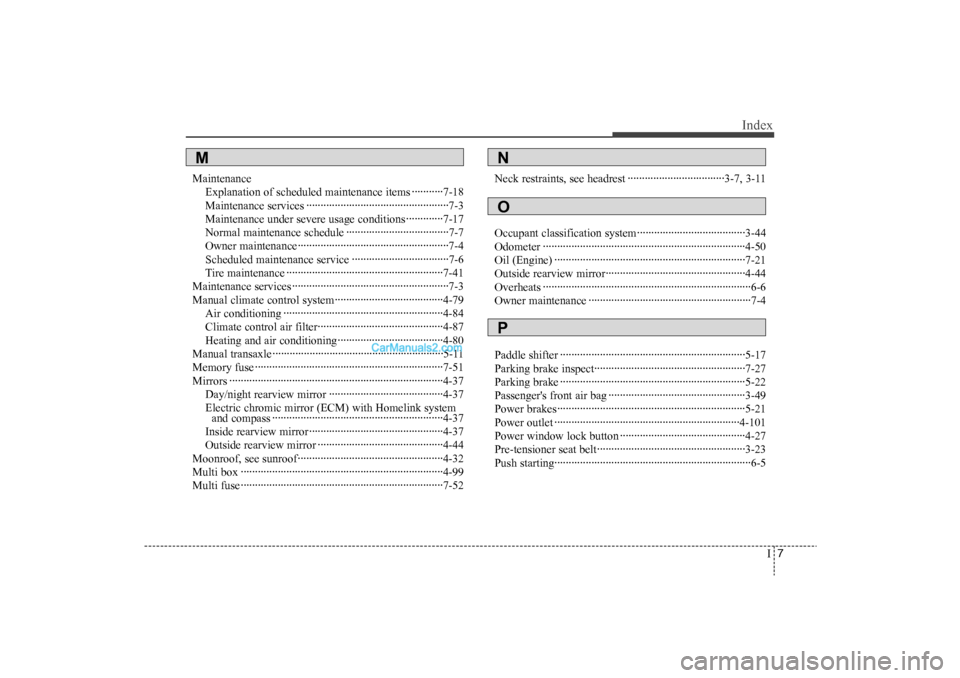
I7
Index
MaintenanceExplanation of scheduled maintenance items ···········7-18
Maintenance services ··················\
··················\
··············7-3
Maintenance under severe usage conditions ·············7-17
Normal maintenance schedule ··················\
··················\
7-7
Owner maintenance··················\
··················\
·················7-4
Scheduled maintenance service ··················\
················7-6
Tire maintenance ··················\
··················\
··················\
·7-41
Maintenance services ··················\
··················\
··················\
·7-3
Manual climate control system··················\
··················\
··4-79 Air conditioning ··················\
··················\
··················\
··4-84
Climate control air filter··················\
··················\
········4-87
Heating and air conditioning··················\
··················\
·4-80
Manual transaxle ··················\
··················\
··················\
······5-11
Memory fuse ··················\
··················\
··················\
············7-51
Mirrors ··················\
··················\
··················\
··················\
···4-37 Day/night rearview mirror ··················\
··················\
····4-37
Electric chromic mirror (ECM) with Homelink systemand compass ··················\
··················\
··················\
······4-37
Inside rearview mirror··················\
··················\
···········4-37
Outside rearview mirror ··················\
··················\
········4-44
Moonroof, see sunroof··················\
··················\
···············4-32
Multi box ··················\
··················\
··················\
·················4-99\
Multi fuse ··················\
··················\
··················\
·················7-52\
Neck restraints, see headrest ··················\
················3-7, 3-1\
1
Occupant classification system··················\
··················\
··3-44
Odometer ··················\
··················\
··················\
·················4-50\
Oil (Engine) ··················\
··················\
··················\
·············7-21
Outside rearview mirror··················\
··················\
·············4-44
Overheats ··················\
··················\
··················\
··················\
·6-6
Owner maintenance ··················\
··················\
··················\
···7-4
Paddle shifter ··················\
··················\
··················\
···········5-17
Parking brake inspect··················\
··················\
·················7-27\
Parking brake ··················\
··················\
··················\
···········5-22
Passenger's front air bag ··················\
··················\
············3-49
Power brakes··················\
··················\
··················\
············5-21
Power outlet ··················\
··················\
··················\
···········4-101
Power window lock button ··················\
··················\
········4-27
Pre-tensioner seat belt··················\
··················\
················3-23
Push starting··················\
··················\
··················\
···············6-5M
NOP
YF HMA INDEX.QXP 1/13/2010 2:11 PM Page 7